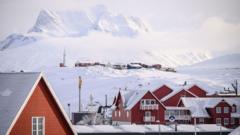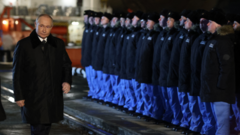The U.S. military base in Greenland, now known as Pituffik Space Base, plays a crucial role in American defense strategies. With renewed focus following governmental visits, experts emphasize its significance in missile detection and national security.
# Reassessing American Military Presence in Greenland: A Strategic Perspective

# Reassessing American Military Presence in Greenland: A Strategic Perspective
The Pituffik Space Base in Greenland serves as a pivotal military site for the U.S., with new attention following recent political developments.
The Pituffik Space Base, formerly Thule Air Base, located in northwestern Greenland, is one of the key military installations for the United States, playing a significant role in global defense strategies. Despite its importance, many Americans remain unaware of its operational significance. “It is quite literally the outermost eye of American defense,” states Peter Ernstved Rasmussen, a Danish defense analyst. He emphasizes the base's vital functions, such as detecting missile launches, calculating trajectories, and activating defense systems, asserting that it is irreplaceable.
Recent political moves have drawn attention back to Pituffik. President Trump’s administration has sent a high-level delegation, including Vice President JD Vance, to the site. Vance expressed his eagerness to connect with “our guardians” in the Space Force during the visit, indicating an emphasis on military relations in the region.
At present, approximately 150 personnel from the U.S. Air Force and Space Force are stationed at Pituffik. Their duties encompass missile defense and space surveillance, with capabilities including the Upgraded Early Warning Radar that can detect ballistic missiles almost immediately after launch. In addition to these permanent staff, the New York Air National Guard adds around 70 members each summer to assist in scientific missions.
Historically, the American military presence in Greenland dates back to World War II, when the U.S. established bases to protect the region after Denmark fell under Nazi occupation. This initial agreement with Denmark's ambassador allowed U.S. forces to construct essential airfields and weather stations to secure the territory, highlighting the complex interplay of politics and military strategy that has shaped the base's existence.
As the geopolitical landscape evolves, the role of Pituffik remains crucial, reinforcing its strategic value in the U.S. defense architecture. Ultimately, as discussions about Greenland’s future arise, understanding the implications and historical context of American military presence becomes increasingly significant in the broader framework of international relations and national security.




















